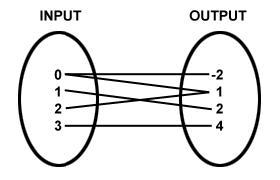Write the equation y=2x+5 in function notation.
f(x)=2x+5
The domain of a function represents the _________ values.
x-values/independent variable
What is another term for rate of change?
slope
A geometric sequence has a common ________.
ratio
When graphed, this type of sequence shows a straight line.
arithmetic sequence
Function or Relation?

Relation
The range of a function represents the ___________ values.
y values/dependent variable
Fill in the blanks. The rate of change formula is: (change in _______) over (change in ________)
change in Y over change in X
An arithmetic sequence has a common ___________.
difference
Evaluate f(x) = 5x +14 when x=5.
39
Function or Relation?

Function
What is the domain of a linear function?
all real numbers or negative infinity to infinity
The rate of change for the following graph: 
2
A recursive formula uses the ___________ to find the wanted term.
previous term
What kind of sequence is the following sequence?
4, 16, 64, 256, ...
geometric sequence
Function or Relation? 
Relation, because each x value can only have 1 y value.
The range of the following graph:

y greater than or equal to -3 or -3</y<infinity
The rate of change of the following graph:
5/-2 (or -5/2)
When graphed, this type of sequence shows an exponential line.
geometric sequence
If f(5)=7(5)-8, what is f(x)?
f(x)=7x-8
What is the definition of a function? or What makes a relation a function?
"each input has one and exactly one output" or each x has only one y.
The range of (1,1), (2, 4), (3, 7), (4, 10), (5, 13)?
{1,4,7,10,13}
The rate of change of (1,1), (2, 4), (3, 7), (4, 10), (5, 13)?
3
What is the 20th term of the following sequence: (2,4,8,16,32,64,...)?
1,048,576
What is the 50th term of the following sequence: (3,5,7,9,11,13,...)?
41